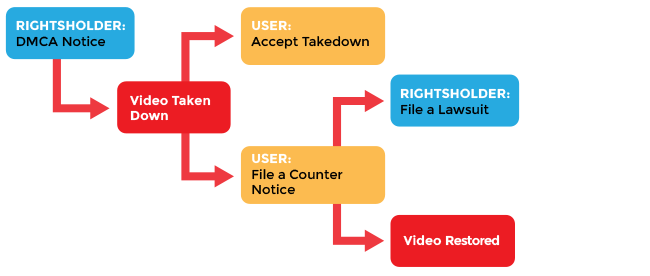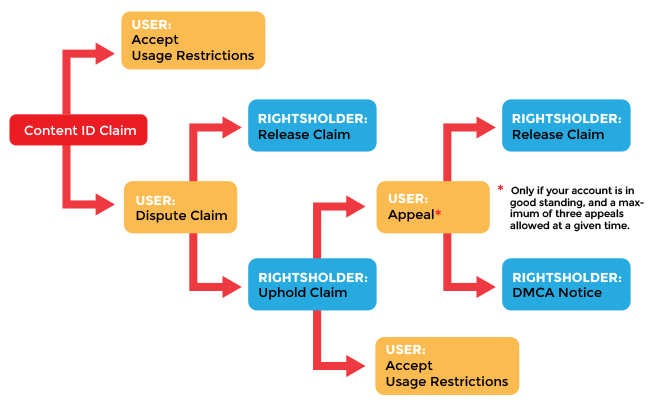Strike 1. Strike 2. Strike 3, and you're out. Just like in baseball or softball, the three-strikes laws also apply on YouTube.
Simply called the YouTube copyright strike, it is a copyright policing practice used by YouTube for the purpose of managing copyright infringement and complying with the Digital Millennium Copyright Act (DMCA). Since YouTube is a place where content creators, copyright owners and viewers gather, YouTube must retain DMCA safe harbor protection, by responding to any copyright infringement claims.
And the company does that by sending notice to content creators, and initiating take down processes.
When YouTubers get hit with the first copyright strike, they will be required to complete Copyright School, by watching a warning video about the rules of copyright and take trivia questions about the danger of copyright.
And after three strikes, YouTube will automatically terminate that users' YouTube channel, including any associated channels that the users have, as well as removing all of the videos on that YouTube channel, and prohibits the YouTuber from creating another YouTube channel.

As explained by Google in a dedicated support page:
"Copyright strikes may affect your ability to monetize. In addition, if your active live stream is removed for copyright, your access to live streaming will be restricted for 7 days."
YouTube does this by relying on bots.
Content creators who create contents that are copyrighted, can get caught by the bots. When they get caught by its Content ID system, YouTube will first send a message to the YouTubers' dashboard
Restriction imposed by Content ID can either deal with copyrighted materials, or a result when a video has been flagged for containing nudity, gratuitous violence, or otherwise in violation of YouTube's Terms of Use or Community Guidelines. The Terms of Service also state that "YouTube reserves the right to remove Content and User Submissions without prior notice."
But when the owners of the copyrighted materials stepped in, they can submit a complete and valid legal takedown request. Whenever YouTube gets this type of formal notification, the company has no choice but to take down the videos to comply with the copyright law.
As part of the MDCA, the U.S. Congress granted online service providers (like YouTube) certain protections from copyright infringement liability, as long as they meet certain requirements. One of the requirements is that online service providers must implement a "notice-and-takedown" system. Another requirement is that YouTube must cancel the accounts of "repeat infringers."
According to Google, a video can only have one copyright strike at a time, and Content ID claims won't.
YouTubers who receive the first and the second copyright strikes, can either wait for 90 days for the strikes to expire, or get a retraction by getting in touch with the person/company who claimed the copyright.
Otherwise, they can submit a counter notification.
If YouTubers think that their video was removed by mistake, or qualifies as fair use, a counter notification will be forwarded to the claimant. After that, the claimant has 10 business days to respond, as required by copyright law.
"They’ll need to respond with evidence that they’ve taken legal action to keep the content from being restored to YouTube," explained Google.
"If you submit a counter notification, your channel won't be disabled while the counter notification is unresolved. If the counter notification is resolved in your favor, or the claim is retracted, your channel won't be impacted," explained Google.
It should be noted that YouTube has what it calls the 'Courtesy Period', where YouTubers who are part of the YouTube Partner Program can be given 7 days to act before their channel is disabled, even after the third copyright strike.
During this period, the copyright strikes won’t expire and the YouTuber cannot upload new videos. However, the channel can remain live, and the YouTuber can access it to seek a resolution for the strikes.

Before YouTubers blame anyone, YouTube should provide its reasons for removing a video or sending a copyright strike.
YouTube does this by sending an email to the YouTuber, and also by sending a notification on the YouTuber's dashboard.
Fortunately for YouTubers, they can deal with copyright strikes right away, and they are given a number of choices.
Given the giant amount of copyrighted materials on YouTube put up there by people without the right to do so, YouTube's best move is to either restrict or block contents that are copyrighted.
A proper DMCA takedown notice must meet certain requirements, such as identifying the infringing material clearly and specifically, and stating that the sender has a 'good faith belief' that the material actually infringes copyright.
But unfortunately for many YouTubers, they must know that YouTube is seeing increasing number of improper requests, and a number of take downs can be based solely on keywords or a purely automated process.
In a report, it was found that more than 90% of DMCA takedown notices are actually sent at random URLs that could have existed (valid format), but is not actually used at all at the point in time the takedown notice is sent. This is the work of bots having no valid claims to any copyright, trying to carpet bomb DMCA notices for various illegal reasons such as trying to ruin a competitor.
This is why a lot of YouTube creators have reported receiving copyright strikes issued against the creators themselves. Making things worse, some publishers on YouTube report not understanding why they have received strikes.
